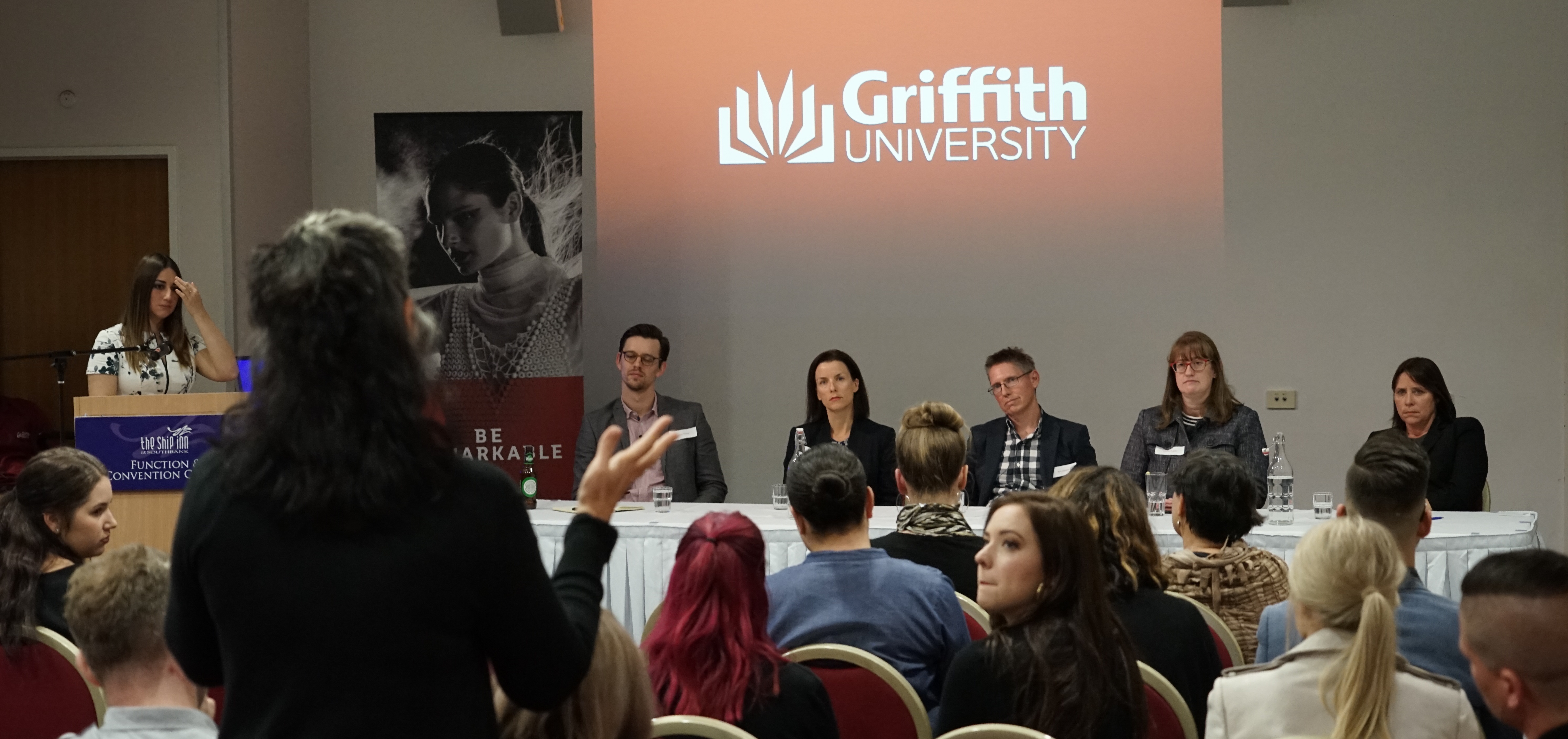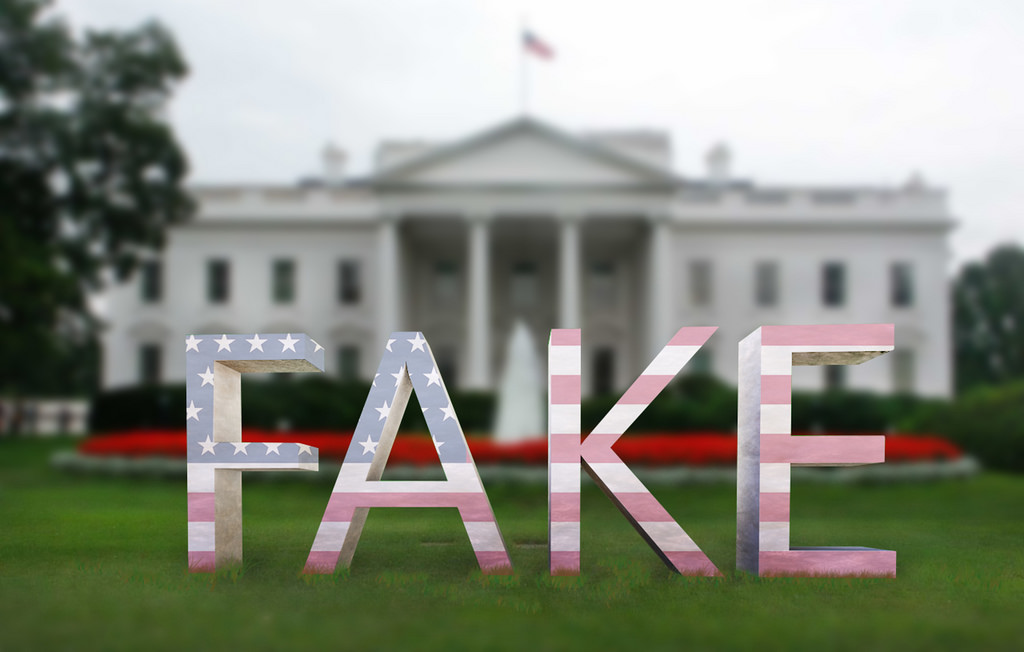Digital strategies around fake news and spin was the compelling topic for discussion when the Griffith Press Club brought together an expert panel of Kellie Riordan (Content and Digital Strategy, ABC Radio), Simon Elvery (Digital Interactive Storytelling, ABC), Rod Chester (National Technology Writer, News Corp Australia), Jennifer Dudley (National Technology Editor, News Corp Australia) and Kathy McLeish (Journalist, ABC News and Current Affairs). Griffith PhD researcher and journalism graduate, Audrey Courty, set the scenein terms of the challenges facing journalists and editors today with the following introductory remarks.
In the last couple of months since the US election, ‘fake news’ has become big news.
For those unfamiliar with the term, fake news is considered deliberate misinformation or hoaxes dressed up as legitimate news stories.
A new report by the Australian Strategic Policy Institute found that in the days just before the 2016 US election Facebook users’ engagement with fake news actually surpassed engagement with mainstream news. The author of the report, Zoe Hawkins, states the infiltration of fake news is ‘unprecedented’ and undermining public debate and the democratic process.
Perceptions of reality shaped by fabricated stories
Notable examples of fake news stories include the claims that Donald Trump had been endorsed by Pope Francis and that Hillary Clinton was selling arms to the Islamic State.
To informed readers, such claims may seem unbelievable; however fabricated stories did shape some people’s perceptions of reality. For example, the US Public Policy Polling revealed that 38% of Florida voters believed Republican candidate Ted Cruz might actually be the mysterious Zodiac Killer from the 1960s. I assume this also means 38% of Florida voters believe in time travel.
Another poll conducted by the Economist and YouGov found that 46% of Trump voters believed that Clinton’s campaign was implicated in a satanic, child-trafficking ring operated from beneath a pizzeria in Washington DC. Interestingly, 17% of polled Clinton supporters also believed this now-disproved theory.
The fake #pizzagate story even inspired one man to drive from North Carolina to Washington DC, firing an assault rifle multiple times into the pizza restaurant.This incident alone illustrated the power of disinformation to activate individual beliefs and behaviours.
 Importantly, however, fake news stories don’t have to convince everyone to be considered effective. Simply creating sufficient confusion can be enough to undermine confidence in official narratives. The Pew Research Center discovered in December 2016 that roughly two-thirds of Americans see fake news as having “caused a great deal of confusion.”
Importantly, however, fake news stories don’t have to convince everyone to be considered effective. Simply creating sufficient confusion can be enough to undermine confidence in official narratives. The Pew Research Center discovered in December 2016 that roughly two-thirds of Americans see fake news as having “caused a great deal of confusion.”
Adding to this confusion is the hijacking of the term “fake news” by politicians like Donald Trump who use it to essentially refer to any news report or media they don’t like.During Trump’s first press conference as president-elect, he refused to take a question from CNN’s White House correspondent Jim Acosta. When Acosta continued to press him for a question, Trump declared: “You are fake news.”Famously, when counselor Kellyanne Conway was confronted on the US administration’s needless lies about inauguration crowd sizes, she proclaimed the Trump team had “alternative facts.”
The US president has continued to escalate his war with the press, calling traditional media sources the “enemy of the people.” He has specifically attacked The New York Times and CNN, accusing them of being dishonest. He has also declared any media reports investigating his campaign ties with Russia as “all fake news.”
Ignoring facts and political speech
Politicians in Australia are also trumpeting the term. A Turnbull government minister accused the ABC of running “nothing but fake news” in its December 2016 coverage of the Adani coal mine.More recently, Treasurer Scott Morrison cried “fake news” when Liberal MPs told media outlets of a renewed push within the Coalition for a free vote on same-sex marriage.‘Fake news’ is even being used in an attempt to sell newspapers. A subscription ad for The Australian says: “You’ve read all the fake news. Now read the real news.”
This kind of political maneuvering is not new. Ignoring the facts has long been a staple of political speech. Every day, politicians overstate some statistic, distort their opponents’ positions, or simply tell lies. Surrogates and pundits then spread the spin.
A 2010 investigation by the Australian Centre for Independent Journalism revealed that 55% of Australian newspaper stories analysed were driven by the public relations industry. In turn, Australians’ trust in news generally remains quite low compared to other developed countries, at 43%.‘Alternative facts,’ ‘fake news,’ and the demonisation of the media are the boldest signs of a post-truth society. When we can’t agree on basic facts – or even that there are such things as facts – how do we talk to each other?
It’s a media ecosystem where “everything is true and nothing is true,” said former US President Barack Obama in a post-election interview with the New Yorker. “The capacity to disseminate misinformation, wild conspiracy theories, to paint the opposition in wildly negative light without any rebuttal – that has accelerated in ways that much more sharply polarise the electorate and make it very difficult to have a common conversation,” he said.
Indeed, these problems have accelerated with the digital age. Information spreads around the world in seconds, with the potential to reach billions of people. But it can also be dismissed with a flick of the finger. What we choose to engage with on social media platforms is self-reinforcing and we get shown more of the same. It results in an exaggerated “echo chamber” effect.The idea of using technology to help break through these isolated information – or, perhaps, misinformation – bubbles that many of us now live in comes up again and again.
